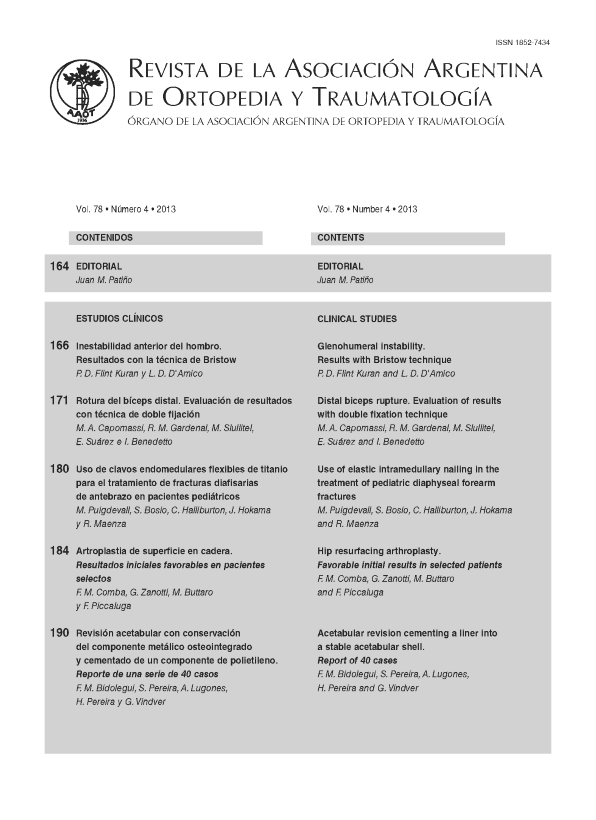Reliability analysis for coronal cobb angle measurements of digitally acquired photograph to the 30 x 90 cm films in adult scoliosis: comparison among two observers and three digital cameras.
Main Article Content
Abstract
Downloads
Metrics
Article Details

This work is licensed under a Creative Commons Attribution-NonCommercial-ShareAlike 4.0 International License.
Manuscript acceptance by the Journal implies the simultaneous non-submission to any other journal or publishing house. The RAAOT is under the Licencia Creative Commnos Atribución-NoComercial-Compartir Obras Derivadas Igual 4.0 Internacional (CC-BY-NC.SA 4.0) (http://creativecommons.org/licences/by-nc-sa/4.0/deed.es). Articles can be shared, copied, distributed, modified, altered, transformed into a derivative work, executed and publicly communicated, provided a) the authors and the original publication (Journal, Publisher and URL) are mentioned, b) they are not used for commercial purposes, c) the same terms of the license are maintained.
In the event that the manuscript is approved for its next publication, the authors retain the copyright and will assign to the journal the rights of publication, edition, reproduction, distribution, exhibition and communication at a national and international level in the different databases. data, repositories and portals.
It is hereby stated that the mentioned manuscript has not been published and that it is not being printed in any other national or foreign journal.
The authors hereby accept the necessary modifications, suggested by the reviewers, in order to adapt the manuscript to the style and publication rules of this Journal.
References
2. Mah ET, Thomsen NO. Digital photography and computerisation in orthopaedics. J Bone Joint Surg Br 2004;86(1):1-4.
3. Schenk MP, Manning RJ, Paalman MH. Going digital: image preparation for biomedical publishing. Anat Rec 1999;257(4):128-36.
4. Donndorff AG, González Della Valle A. Fotografía digital. Conocimientos básicos para su aplicación en ortopedia y traumatología.
Rev Asoc Argent Ortop Traumatol 2003;67:87-94.
5. Rosen Al, Hausman M. Digital imaging and video: Principles and applications. J Am Acad Orthop Surg 2003;11:373-379.
6. Petracchi M, Solá C, Núñez L, Gruenberg M, Ortolán E. Osteotomías virtuales espinales en el deseje sagital. Congreso de la Sociedad Argentina de la Patología de la Columna Vertebral 2004.
7. Gupta MC, Wijesekera S, Sossan A, Martin L, Vogel LC, Boakes JL, et al. Reliability of radiographic parameters in neuromuscular scoliosis. Spine (Phila Pa 1976) 2007;32(6):691-5.
8. Kuklo TR, Potter BK, O’Brien MF, Schroeder TM, Lenke LG, Polly DW, Jr. Reliability analysis for digital adolescent idiopathic scoliosis measurements. J Spinal Disord Tech 2005;18(2):152-9.
9. Kuklo TR, Potter BK, Polly DW, Jr., O’Brien MF, Schroeder TM, Lenke LG. Reliability analysis for manual adolescent idiopathic scoliosis measurements. Spine (Phila Pa 1976) 2005;30(4):444-54.
10. Mok JM, Berven SH, Diab M, Hackbarth M, Hu SS, Deviren V. Comparison of observer variation in conventional and three digital radiographic methods used in the evaluation of patients with adolescent idiopathic scoliosis. Spine (Phila Pa 1976) 2008;33(6):681-6.
11. Cobb JR. Outline for the study of scoliosis. Instruct Course Lect 1948;5:61-75.
12. Rosenfeldt MP, Harding IJ, Hauptfleisch JT, Fairbank JT. A comparison of traditional protractor versus Oxford Cobbometer radiographic measurement: intraobserver measurement variability for Cobb angles. Spine (Phila Pa 1976) 2005;30(4):440-3.
13. Kuklo TR, Potter BK, Schroeder TM, O’Brien MF. Comparison of manual and digital measurements in adolescent idiopathic scoliosis. Spine (Phila Pa 1976) 2006;31(11):1240-6.
14. Naoumova J, Lindman R. A comparison of manual traced images and corresponding scanned radiographs digitally traced. Eur J Orthop 2009;31(3):247-53.
15. Shea KG, Stevens PM, Nelson M, Smith JT, Masters KS, Yandow S. A comparison of manual versus computer-assisted radiographic measurement. Intraobserver measurement variability for Cobb angles. Spine (Phila Pa 1976) 1998;23(5):551-5.
16. Carman DL, Browne RH, Birch JG. Measurement of scoliosis and kyphosis radiographs. Intraobserver and interobserver variation. J Bone Joint Surg Am 1990;72(3):328-33.
17. Morrissy RT, Goldsmith GS, Hall EC, Kehl D, Cowie GH. Measurement of the Cobb angle on radiographs of patients who have scoliosis. Evaluation of intrinsic error. J Bone Joint Surg Am 1990;72(3):320-7.
18. Wills BP, Auerbach JD, Zhu X, Caird MS, Horn BD, Flynn JM, et al. Comparison of Cobb angle measurement of scoliosis radiographs with preselected end vertebrae: traditional versus digital acquisition. Spine (Phila Pa 1976) 2007;32(1):98-105.
19. Pavlovich RI, Vazquez-Vela G, Pardinas JL, Villarreal JMB, Rico EC, Behar GM. Basic science in digital imaging: Digital dynamic radiography, multimedia, and their potential uses for orthopaedics and arthroscopic surgery. Arthroscopy 2002;18:639-47.

